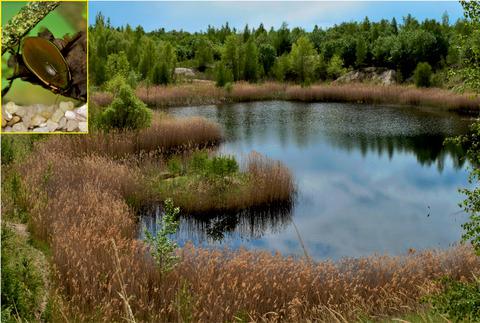当前位置:
X-MOL 学术
›
J. Appl. Ecol.
›
论文详情
Our official English website, www.x-mol.net, welcomes your
feedback! (Note: you will need to create a separate account there.)
Evidence-based restoration of freshwater biodiversity after mining: Experience from Central European spoil heaps
Journal of Applied Ecology ( IF 5.0 ) Pub Date : 2021-06-23 , DOI: 10.1111/1365-2664.13956 Vojtech Kolar 1, 2 , Filip Tichanek 1, 3 , Robert Tropek 1, 4
中文翻译:

采矿后淡水生物多样性的循证恢复:来自中欧弃土堆的经验
更新日期:2021-06-23
Journal of Applied Ecology ( IF 5.0 ) Pub Date : 2021-06-23 , DOI: 10.1111/1365-2664.13956 Vojtech Kolar 1, 2 , Filip Tichanek 1, 3 , Robert Tropek 1, 4
Affiliation

|
- Post-mining freshwater habitats can serve as secondary habitats for threatened species. Being globally plentiful, their efficient restoration should be based on detailed evidence, especially under the current global decline of freshwater biodiversity. Synthetic studies focusing on the effects of restoration on freshwater communities are surprisingly rare, even for the most common restoration approaches. Such a lack of evidence limits the efficiency of habitat restoration in post-mining landscapes.
- We combined a landscape-scale field study of aquatic beetles and hemipterans in 29 freshwater pools at lignite spoil heaps in Czechia with a comparative synthesis of all 14 available datasets on freshwater communities at habitats created by coal mining in Central Europe. We compared the diversity and conservation value of freshwater habitats created by the main restoration approaches, including technical reclamation, spontaneous succession and their combination. Additionally, we analysed the detailed influence of key habitat descriptors on their conservation potential.
- Communities of aquatic beetles and hemipterans had more species in spontaneously and semi-spontaneously developed pools, which were also preferred by more red-listed species of both studied groups. The reviewed studies showed the same trend for amphibians, odonates, dipterans and macrozoobenthos, although some technically created pools and drainage ditches harboured some threatened species of aquatic plants, odonates and macrozoobenthos as well.
- Relatively independent of the restoration approach, the conservation value of freshwater communities was related to the particular characteristics of the restored habitats. The key beneficial features were as follows: smaller area of restored water bodies, heterogeneous littoral vegetation with suppressed dominants, heterogeneous bottom substrate with low and gradually sloping banks, absence of fish, sun-exposed water surface and some forests in the surroundings.
- Synthesis and applications. Efficient restoration of freshwater habitats at post-mining landscapes can create important secondary refuges for threatened and common species. Freshwater communities of high conservation value can be supported by all main restoration approaches if heterogeneous habitats are created. A combination of technical reclamation with spontaneous succession seems to be the most efficient approach to maximise biodiversity in freshwater habitats at coal-mining spoil heaps.
中文翻译:

采矿后淡水生物多样性的循证恢复:来自中欧弃土堆的经验
- 开采后的淡水栖息地可以作为受威胁物种的次要栖息地。由于全球丰富,它们的有效恢复应基于详细的证据,尤其是在目前全球淡水生物多样性下降的情况下。关注恢复对淡水群落影响的综合研究非常罕见,即使对于最常见的恢复方法也是如此。这种缺乏证据限制了采矿后景观中栖息地恢复的效率。
- 我们将捷克褐煤弃土堆的 29 个淡水池中水生甲虫和半翅目昆虫的景观规模实地研究与中欧煤矿开采栖息地淡水群落的所有 14 个可用数据集的比较综合相结合。我们比较了主要恢复方法所创造的淡水栖息地的多样性和保护价值,包括技术复垦、自发演替及其组合。此外,我们分析了关键栖息地描述符对其保护潜力的详细影响。
- 水生甲虫和半翅目群落在自发和半自发发展的水池中有更多的物种,这也是两个研究组中更多红色名录物种的首选。审查的研究表明两栖动物、齿类动物、双翅目动物和大型底栖动物的趋势相同,尽管一些技术上建造的水池和排水沟也藏有一些受威胁的水生植物、齿类动物和大型底栖动物。
- 相对独立于恢复方法,淡水群落的保护价值与恢复生境的特定特征有关。主要有益特征如下:恢复水体面积较小,沿海植被异质性,优势受到抑制,底质异质,低矮且逐渐倾斜的河岸,没有鱼类,水面暴露在阳光下,周围有一些森林。
- 合成与应用。在采矿后景观中有效恢复淡水栖息地可以为受威胁和常见物种创造重要的二级避难所。如果创造了异质栖息地,所有主要的恢复方法都可以支持具有高保护价值的淡水群落。将技术复垦与自发演替相结合似乎是最大限度地提高煤矿弃土堆淡水栖息地生物多样性的最有效方法。











































 京公网安备 11010802027423号
京公网安备 11010802027423号